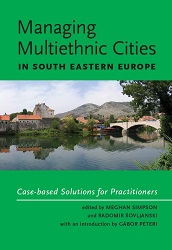Truth, Responsibility, and Reconciliation: Bajina Bašta and Srebrenica
Truth, Responsibility, and Reconciliation: Bajina Bašta and Srebrenica
Author(s): Boban Tomić
Subject(s): Politics / Political Sciences, Politics, Civil Society, Governance, International relations/trade, Inter-Ethnic Relations, Geopolitics
Published by: Centar za regionalizam
Keywords: Bajina Bašta; Srebrenica; Center for Regionalism; regional cooperation
Summary/Abstract: Bajina Bašta, a municipality in Serbia, and Srebrenica, a municipality in Bosnia and Herzegovina, are divided, or linked, by the Drina River. Cooperation between these two municipalities while part of the former Yugoslav federation was extremely good, including a high level of interaction in economic areas. During the wars of the 1990s, an estimated 7,000 civilians were massacred in a few days in July 1995 in Srebrenica. A site of one of the greatest crimes against humanity since the Second World War, the town became a symbol of suffering. Srebrenica was in fact shelled from the territory of Bajina Bašta municipality—more precisely, from the slopes of Mount Tara in Serbia. Thus, many in Srebrencia have resisted renewing cooperation with their neighbors after the cessation of the war. However, seeking to overcome recent tragedies, local civic organizations took the lead in rebuilding ties. In 2005, upon the initiative of Agora, an NGO from Bajina Bašta, and the Center for Regionalism, from Novi Sad, representatives of the two municipalities—including local officials and NGOs—signed an Agreement on Interethnic Tolerance. This agreement served as the basis for reestablishing intermunicipal cooperation in a range of areas, based on principles of tolerance and trust. Among the most important cross-border initiatives has been the creation of a Cross-border Development Agency, which has built strong economic links between the two municipalities as well as with neighboring municipalities on both sides of the Drina River. The renewal of economic cooperation has been a crucial step in dismantling rigid barriers that were created during the war.
Book: Managing Multiethnic Cities in South Eastern Europe - Case-based Solutions for Practitioners
- Page Range: 113-136
- Page Count: 24
- Publication Year: 2010
- Language: English
- Content File-PDF

